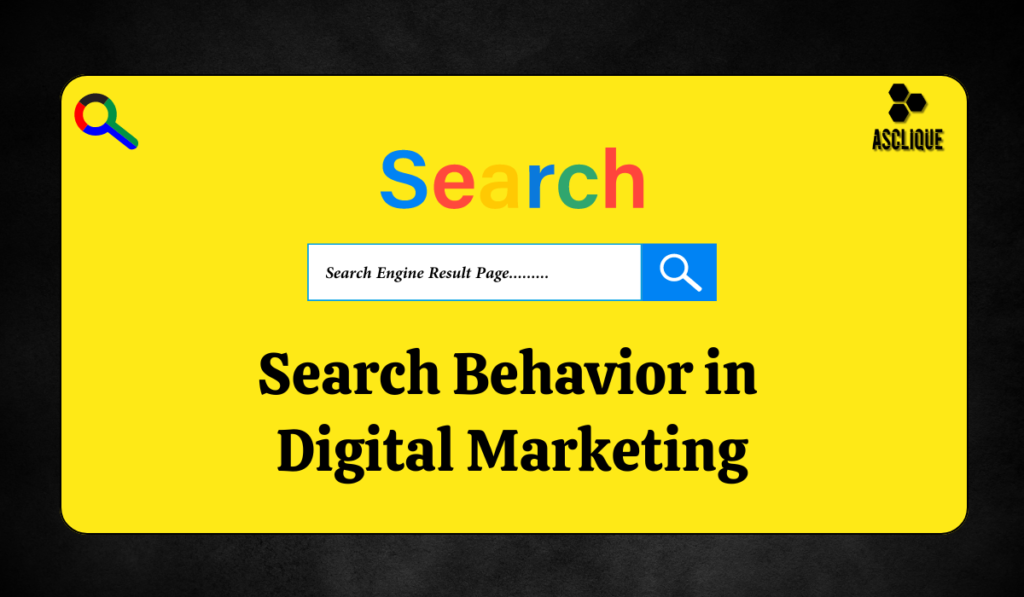Search Behavior in Digital Marketing is an important part of formulating successful strategies in today’s fast-paced digital environment. Business goes about realizing how people are searching online, whether the search engine or voice search.
Identifying search behavior helps marketers and market researchers come out with information on what their audience needs, what they want, and the path of journey from search query to conversion. The marketer can thereby create targeted strategies that convert a search into a customer.
What is Search Behavior in Digital Marketing?
Search Behavior in Digital Marketing is the way through which people search for information on the net. What this therefore entails, is what the individual might be searching for, what the intent behind the search may be – it might be informational, transactional, or navigational – and the journey of the searcher from the first search all the way to the final conversion.
Therefore, one who searches for “best running shoes for beginners” is more likely at the research stage of the conversion funnel, while one who looks for “buy Nike Air Zoom size 9” is closer to a final conversion.
Why Does Search Behavior in Digital Marketing Matter?
Search Behavior in Digital Marketing matters because it helps marketers know better the needs of their audience at each stage of the buyer’s journey. A search query may indicate that the person is looking for information only or is ready to buy; hence, it may help marketers boost the optimization of their SEO approaches and make campaigns turn potential customers into conversions.
Key Stats to Understand Search Behavior:
- 80% of shoppers begin their purchase process by opening a search engine.
- 75% of users never look past the first page of search results.
- 50% of queries contain four or more words, reflecting the greater specificity with what people are searching for.
Types of Search Intent
To optimize content in Search Behavior under Digital Marketing, it is essential to know the intent of a user. Three categories of search intent exist:
Informational Search
They are looking for knowledge or answers. They are at the top of the funnel, not ready to buy, but are looking for useful information about something.
- Example: “How to grow new startups”.
- Optimize: Build detailed tutorials, guide articles and teaching blog posts, and provide clear headings.
Navigational Search
Consumers are trying to find a particular brand or website. These search terms primarily demonstrate brand loyalty.
- Example: “Facebook login” or “Nike official store.”
- Optimize: Make sure that the brand has some serious online presence, its web pages ought to be easy to find.
Transactional Search
Users are ready to purchase or action oriented. This intention will directly head towards conversion.
- Example: “Buy iPhone 15.”
- Optimize: Work on product pages, calls-to-actions, and clear paths to buy.
As a marketer, knowing which kind of search to target with what will actually help target the right audience with the right content. Example: Blog posts and how-to guides would be the best fit for informational searches, whereas product pages and offers would serve transactional search best.
From Keywords to Conversions: How to Leverage Search Behavior
- Research Long-Tail Keywords: Like “best budget running shoes 2024,” long-tail keywords are more specific and tend to have lower competition. They most of the time represent users who are closer to the point of purchase.
- Create Intent-Driven Content: Align your content with the intent behind the search query. If a user’s search indicates that they’re ready to buy, make sure that they land on a product or service page rather than a blog post.
- Optimize for Mobile: Over half of search volume takes place on mobile.You’re most likely losing out on potential clients if your website is not optimized for mobile devices.
- Voice Search Optimization: With smart speakers, 20% of searches take place through voice. Thus, you will now have to spend your keywords on natural conversational phrases.
- Monitor Analytics: With tools such as Google Analytics, you can monitor how users behave after a search. From the time they browse to search and then converting, you may get the clue on what to improve on and what works.
The Importance of User Experience
User Experience, although woefully underrepresented, plays a huge role in Search Behavior in Digital Marketing and is what would ultimately translate into conversions. Users will bounce and head to the competitor if they land on your page but it’s too hard to navigate or takes too long to load. Your website should be easy to use, load quickly, and have clear paths to conversion.
Conclusion
Understanding search behavior in digital marketing is not merely knowing the right keywords, but it is knowing what you want and getting it right for them, offering content. This results in frictionless experience while looking up to conversion, which will significantly boost your digital marketing efforts with better results.
FAQ’s
What is search behavior in digital marketing?
It is described as search behavior that refers to how people use search engines to find information-helping marketers tailor their strategies to meet the needs of the users.
Why is search intent important?
Search intent shows if the user wants information, is navigating to a website, or is ready to make a purchase. This can be used by marketers to produce pertinent information.
How does mobile optimization affect search behavior?
Since more than 50% of the searches happen through mobile devices, a mobile-friendly website ensures that its users have a smooth experience while on the website, and consequently, there are higher conversion rates.
What are long-tail keywords?
Long-tail keywords are phrases that are narrower, more specific, with a lower search volume but a higher conversion potential, being closer to the focus of user intent.

